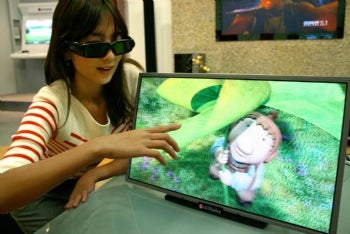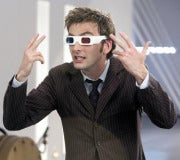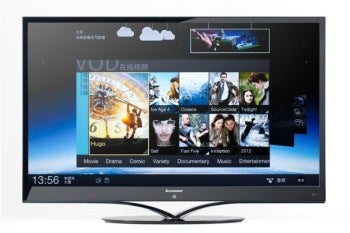 The bloom is off 3D this year at CES (formerly the Consumer Electronics Show). It’s as if last year’s CES, where 3D TVs were all the rage, never happened. How did 3D—in one short year—go from darling to dud?
The bloom is off 3D this year at CES (formerly the Consumer Electronics Show). It’s as if last year’s CES, where 3D TVs were all the rage, never happened. How did 3D—in one short year—go from darling to dud?
The answer is a combination of things such as a dearth of 3D content, a technology that has not evolved fast enough, and the arrival of more-compelling HDTV tech for TV makers to push over 3D.
The big TV makers—LG, Panasonic, Samsung, Sony, and Vizio—are noticeably grounded in 2D here at CES. Instead of touting new 3D tech, they are pushing new OLED display technology, promoting new content delivery services, TV-based apps, and features such as voice commands for couch potatoes too lazy to pick up a clicker.
The truth is that 3D isn’t dead, it has just gone into a hibernation of sorts. I’ll get into why, but for the time being, expect 3D technology to be pushed to the background for the next year or two. But don’t you worry—3D is coming back, and when it does, it will be with a vengeance.

This LG 3D display requires shutter glasses.
The 3D dilemma
For the last two years, 3D technology has been crammed down our throats with varying degrees of success by HDTV makers. Why? For manufacturers, 3D has been a compelling feature on multiple grounds. Number one, it gave consumers a reason to upgrade their HDTVs to something undeniably cool—3D. Also, once TV makers had developed the 3D technology, they were able to add 3D functionality to their sets at little cost to them—but more cost to us. And even better, if you’re a major consumer electronics company, such as Panasonic, you can use those 3D TVs to sell 3D cameras, and push smartphones and tablets.
But what happened over the past few years was that 3D image quality levels among the major HDTV makers hovered only around a generally good—but not amazing—level. That makes it hard to sell to new and existing 3D HDTV customers who have to dig deep into their shrinking savings and justify the purchase of a new 3D HDTV with only incremental image quality enhancements.
Unlike with other tech niches, where the chips get faster and the laptops get thinner, with 3D the technology wasn’t evolving fast enough to keep consumers interested. If you were one of many who loathed TV makers pushing 3D on you, there was no breakthrough content or 3D technology to make you a convert.

3D faithful lose their faith
In short, 3D hasn’t been such an easy sell for consumers—which is why relatively few TV buyers have been enthusiastic about 3D over the past few years. Consumers really ask just two questions:
- “Do I want to watch this show?”
- “Do I want to watch this show in 3D?”
But practically no one is excited enough about 3D that they’d watch something they wouldn’t normally watch just to get the 3D experience. If you don’t like stoner comedies or blood sports, you’re not going to be interested in A Very Harold and Kumar Christmas 3D or the Ultimate Fighting Championship 3D.
Still, if you do want to watch what limited 3D programming there is, then we come to a third question: “Do I like the 3D effect enough to put up with active-shutter or passive 3D glasses?”

Goofy Glasses Syndrome
Both active-shutter and passive 3D glasses technology have stabilized. Passive 3D was big news last year at CES, and active-shutter the year before that. But it seems as if we’ll see mostly incremental updates for the next year or so—lighter glasses, minor image processing features, and so on. We’ve seen a lot of hoopla over glasses-free 3D displays. That technology, though, is still best suited for small-screen devices such as the Nintendo 3DS and phones such as the HTC Evo 3D.
The 3D road to progress is sluggish, and that doesn’t give HDTV buyers reasons to hold off a purchase for the next big thing in 3D. No TV maker here at CES has convinced me that a significant 3D update will surface in 2012.
Content conundrum
What is also holding back 3D is content. Even the most enthusiastic 3D booster will have to admit that if the TV industry wants to sell more 3D TVs, 3D glasses, and 3D Blu-ray players, it must expand the amount of 3D content.
The bad news is that companies like Samsung, LG, and Vizio can’t do a whole lot to fix the lack of diverse 3D content to expand their pool of potential 3D TV buyers. They are tech manufacturers, not entertainment producers. Most efforts appear limited to trying to strike more deals to get 3D content channels in their Smart TV features (which Samsung reps mentioned briefly during their press conference). Instead, at CES, Samsung and LG have been focusing on their upcoming OLED display technologies and on a new set of various apps and services.
Sony and Panasonic, on the other hand, are in the business of both entertainment and tech. Sony has the PlayStation 3, which can do 3D gaming, and also has a massive presence in the film and music industries. Panasonic also is deeply entrenched in Hollywood and provides much of the professional-grade 3D cameras used to make 3D films and sports broadcasts. Unlike other major HDTV manufacturers, it can drive more 3D content production to expand its audience.
Sony and Panasonic have both been talking at CES about how they’re betting hard on 3D in the next year, but not necessarily about 3D inside the TVs themselves. Translation: Expect more 3D movies this year at your local Cineplex.

Lenovo's new TV set, being shown at this week's CES in Las Vegas, recognizes voice commands and runs Android 4.0 applications.
TV makers ditch “3D” for “Smart” in 2012
If you look back, you might have thought Internet-connected “smart TVs” would have been the big thing in HDTV over the past two years. But instead, HDTV enthusiasts were saturated with 3D features, whether consumers liked them or not.
This year at CES, the buzz is about smart TVs that stream content and have apps. Samsung and LG are showing off smart TVs that run applications such as games and connect to movie-streaming services like Netflix. Lenovo is showing a TV based on Android 4.0 with natural language processing and speech recognition technology.
The pool of potential 3D TV buyers will increase at a slow but steady rate as more and better 3D content makes its way onto Blu-ray discs, streaming video channels, and live broadcasts. However, I won’t expect to see 3D come back in a big way at CES until a major shift in HDTV tech happens.
The breakthroughs I’m keeping tabs on are OLED display technology and Sony’s Crystal LED display technology. Both will improve an HDTV’s ability to display 3D effects. Glasses-free 3D tech will continue to improve as manufacturers find different ways to solve the viewable-angle problem.
I wouldn’t be surprised to see a satisfactory glasses-free 3D prototype at next year’s CES, a ridiculously expensive one in 2014, and a pricey but reasonably worthwhile model in 2015—just in time for everyone who bought a 3D TV in the last pwo years to consider upgrading. Lucky you.


